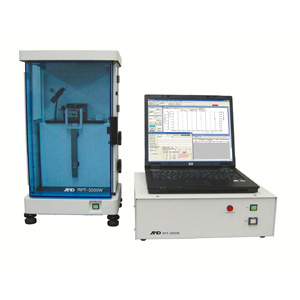A&D > Test and Measurement > RPT-3000W

RPT-3000W
- RPT-3000W is a highly accurate instrument for analysis of curing behavior from liquid to solid state and for practical evaluation of physical properties.
- ISO 12013-1:2012
Paints and varnishes — Determination of curing characteristics using a free damped oscillation method — Part 1: Start temperature of the curing reaction
https://www.iso.org/standard/51147.html - ISO 12013-2:2012
Paints and varnishes — Determination of curing characteristics using a free damped oscillation method — Part 2: Glass transition temperature
https://www.iso.org/standard/51148.html
Additional Links
-
Swing Angle(Maximum) ±0.573 degrees Angle Resolution 1.749e-5 degrees Swing Displacement Detection Inductance Non - Contact Type
Displacement SensorPeriod of Vibration 0.05 ~ 2.000 sec Logarithmic Damping Ratio 0.001 ~ 6.000 sec Test Temperature -100 ~ +400 degrees Celsius Cooling System Liquid Nitrogen Measurement Time 1 ~ 9999 minutes Option Ultraviolet Irradiation Device Dimensions / Weight Main Body : 300 × 220 × 525 / 15kg
Controller : 410 × 350 × 135 / 12kgSafety Device Safety Lamp for increasing temperature
(It turns on at 50 degrees)Power Supply 100V AC 50 / 60Hz 550VA Specifications subject to change for improvement without notice.
Rigid-body Pendulum Type Physical Properties Testing Instrument RPT-3000W
- Recommended installation

Two-sided UV radiation

Oblique view
- Vibration Analysis
When the material is cured and dried, the components, which organize the material, increase their molecular weight through a chemical reaction, called a Chemical Network. The chain molecule moves by thermals and generates a phenomenon called Yarn's Entanglement, and becomes a Physical Network. When fillers, like pigments, are added to the system, the material absorbs the fillers, although absorption depends on the materials. This is called a Physical-Chemical Networks. The effect appears in the form of a molecular increase. When the material is placed on the base plate, material absorption takes place on the base plate and becomes a Physical-Chemical Network. An increase in molecular weight causes an increase in viscosity, and when it is vibrated in a high viscosity solvent, the amplitude of vibration decrease and makes logarithmic damping ratio greater. Therefore, by evaluating the logarithmic damping ratio, the viscosity change caused by the creation of the network can be measured. With the molecular weight, even if it is due to the same network, the viscosity lowers when the temperature rises, and the logarithmic damping ratio becomes small. When the network is created, the size of the network becomes too small.
When the size of the network is greater, the pendulum moves a great distance in order to crush or stretch the network. Therefore, the period of time the pendulum swings increases. However, when the network is created and the size of the network decrease, the distance of the pendulum movement shortens. By measuring the frequency, that is the time of pendulum movement, the size of the network due to the cross linking can be measured. Thus, the curing and drying conditions of the materials can be evaluated by analyzing the logarithmic damping ratio and the change of frequency.
- RPT
All materials become a solid state from a liquid state through some action (heat, light, time and others), and produce various physical properties. The change of phase from liquid to solid causes various problems. Due to this fact, there are cases that the expected performance design cannot be achieved and the performance of the material is lowered and changed by some environmental factor in the process. The most important evaluation item among the material evaluations is to pursue the aging change of the chemical-physical performances in the process of curing and drying from a liquid state to a solid state.
The instrument developed for this evaluation purpose is a rigid-body pendulum type physical properties testing machine, model RPT-3000W.
Sample of how to read a graph

Features
- Use a wide variety of test substrates
- Use a wide range of temperatures: -100 °C to 400 °C
- Schedule testing under varying temperatures: up to a10 step difference (plus or minus)
↓
FeaturesBenefits
- Simulation can identify the most effective production schedule and the best materials composition for the designed property.
Available to Evaluate Materials in Versatile Fields
With this instrument, one can evaluate the curing and drying process of organic high polymeric materials, and their bulk physical properties, or evaluate the surface's physical properties and other materials, such as inorganic material like concrete, cosmetics, paper and foods in the operational temperature range from -100 degrees Celsius to 400 degrees Celsius.
MEASUREMENT
Fix the test piece coating plate on the cooling/heating block. Set the pendulum so that the knife-edge, the fulcrum of the swing, comes vertically into contact on the test piece coated surface. Apply free vibration to the pendulum. For measurement of physical properties, use a cylindrical edge. By analyzing this vibration, the curing process and surface's physical properties can be evaluated.


Rigid-body pendulums

Coating tool(CT)

Cooling/heating block(CHB-100)

Cooling/heating block(CHB-200)

EXAMPLES OF TYPICAL MEASUREMENT
[Curing Behaviours]
Emulsion Polymer

Paints

Adhesives

UV Curing resin

Physical Properties
Polyester coated nylon fiber

Coated film for Piano

Surface Curing
Surface Physical Properties

Internal Physical Properties

- Application of RPT - 3000W
This instrument allows measurement of viscoelastic physical properties under a curing process, as well as the surface layer physical properties of the material. Therefore, this instrument is applicable for development/ improvement, quality evaluation, designing and trouble-shooting production line and life evaluation of materials.
Coating and Adhesives -Curing temperature and curing time
-Curability applied by curing agent and physical properties
-Designing data for painting line
-Quality evaluation for coated film and thin film
-Absorption and lotionsCosmetic and Medical -Drying characteristics and surface physical properties of nail polish
-Drying behavior, adhesive behavior and elastic behavior of cosmetic pack and adhesive agent
-Lubrications and lotionsFood -Gelling behavior and physical properties of gelatin and agar
-Functional and quantitative evaluationTextiles -Physical properties
-Fabric handlingPlastics -Surface physical properties
-Film Physical properties
-For evaluation of surface and internal physical hard coat curing processInk -Physical properties of ink on item to be printed
-Dryability
-Transcribing behavior to rollerElectronics and Electricity -For evaluation of conductivity paste curing process
-For evaluation of low melting solder melting and set process
-For evaluation of printed circuit board curing process and physical propertiesOthers -Concrete and asphaltic materials
- Technical Documentation
Conduction path development in electrically conductive adhesives composed of an epoxy-based binder
Effect of binder chemistry on the electrical conductivity of air-cured epoxy-based electrically conductive adhesives containing copper
Evolution of Electrical Conductivity in Silver-Loaded Electrically Conductive Adhesives Composed of an Amine-Cured Epoxy-Based Binder
What is a rigid pendulum type physical property testing machine? Monthly “Coating Technology" (August 2016 Issue) Technical Report
(Link to Japanese document)
Cosmetics Physical Property Evaluation Method from the October 2012 Issue of Cosmetic Stage "Physical Property Evaluation Method of Cosmetics"
(Link to Japanese document)
Evaluation example of two-component epoxy adhesive
(Link to Japanese document)
Measurement example of high polymer film
(Link to Japanese document)
Physical characteristics of hair damage
(Link to Japanese document)
Measurement example of copper wire coating
(Link to Japanese document)
How to read measurement data (curing)
(Link to Japanese document)
How to read measurement data (physical characteristics)
(Link to Japanese document)
- Academic Papers
Evaluation of the auxiliary effects of the finish applied by concrete curing agents
This is a research report that evaluated the change in viscoelastic behavior of cement paste using a rigid pendulum physical property testing machine using the relative complex elastic modulus.
Evaluation of the Auxiliary Effects of the Finish Applied by Concrete Curing Agents
* This paper is open access, but the copyright belongs to the Institute of Industrial Science, University of Tokyo.
Structure and physical properties of inorganic-organic hybrid coating film model
Minoru Tsubota, Hiroshi Fukui: "Structure and Physical Properties of Inorganic-Organic Hybrid Coating Film Model"
Coating Technology Vol. 55 No.1 p.4-17 (2020)
(Only the abstract, the copyright belongs to the Japan Coating Technology Association)
(Link to Japanese document)
Standardization of methods for measuring the physical properties of paints and coatings using a rigid pendulum
Atsuo Inoue: Standards Certification Resarch & Development Business "Standardization of Methods for Measuring Physical Properties of Paints and Coating Films using a Rigid Pendulum"
Coating Technology Vol. 55 No.1 p.4-17 (2020)
(Copyright belongs to Japan Paint Inspection and Testing Association)
(Link to Japanese document)
Introduction of PS Nano Thin Film Measurement
We were studying how thin materials could be measured and evaluated using the RPT-3000W. We would like to thank the Tanaka Laboratory of the Department of Applied Chemistry, Graduate School of Engineering, Kyushu University for providing us with a PS thin film sample created on a silicon wafer for measurement.
Introduction of PS Nano Thin Film Measurement with RPT-3000W
(Link to Japanese document)
Curing Rate Analysis of Coating Film
Kanji Mori: Curing Rate Analysis of Coating Film - Rate-determining Process with Catalyst-added MEKO Blocked Isocyanate - Color Material., 89 [5], 145-148 (2016)
* This paper is open access, but the copyright belongs to the Japan Society of Coloring Materials.
Method for Tracking Crosslink Density during Curing Process of a Coating Film
Kanji Mori: Method for Estimating Crosslink Density in Curing Process of Coating Films - Proportionality between Storage Modulus and Crosslink Density - Color Material., 86 [4], 123-127 (2013)
* This paper is open access, but the copyright belongs to the Japan Society of Coloring Materials.
Viscoelasticity Measurement of Coating Film Formation by Free Damping Vibration of a Rigid Pendulum
Seiji Ushiama: Viscoelasticity Measurement of Coating Film Formation by Free Damping Vibration of a Rigid Pendulum
* This paper is open access, but the copyright belongs to the Japan Society of Color Material.
Polymer Inclined Structural Material
Saburo Akiyama / Yoshihisa Kano: Inclined Domain Structure Expressed in Polymer Films and Application to New Adhesive Films
Polymer, Volume 49, January Issue (2000) Serialization, Recent Advances in Polymer Science
(Link to Japanese document)
Finding the Crystallinity of a Polymer Surface
Finding the crystallinity of a polymer surface (Publication of Japanese Patent Application No. 2007-292636A)
(Link to Japanese document)

User needs to purchase the following PC and Database software for RPT-3000W.
MSAT (Multi Signal Analysis Testing)
Data processing software
The MSAT series is equipped with functions for not only testing machine operation but also data analysis, calculation and data storage for each testing mode. The operator can select curbing behaviors or physical properties depending on the purpose of the test.
PC operation environment OS: Windows XP Professional. Program size: 80Mb or smaller. Memory requirement: 512Mb or over. Authority requirement: Administrator authority. USB: One USB port. Display resolution: 800x600 dots or higher color display.

